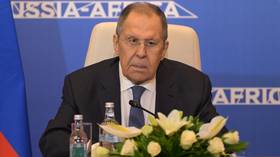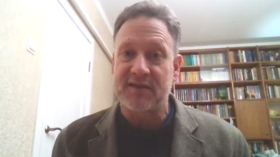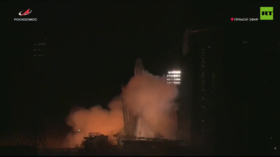‘Any country with a nuclear plant is a bomb factory’

There are countries who are selling nuclear reactors all around the world, which means they are not only selling cancer and leukemia to the future generations, but also atomic bombs, anti-nuclear advocate Dr. Helen Caldicott said in RT’s Google Hangout.
During the hangout, Helen Caldicott, answered a variety of RT readers’ questions on topics, ranging from those of immediate importance, like the Fukushima crisis, to the prospects of humanity living through the nuclear age.
Q: Should we all move to Africa in case TEPCO
fails to remove the spent fuel rods?
Helen Caldicott: Number one: this is an
impossibility. There are billions of people in the Northern
Hemisphere and what happens is that if there is a huge release of
radiation from Fukushima by accident or by the fuel rods burning,
or a fission reaction taking place, the radiation will circulate
from west to east around the Northern Hemisphere, but as air
masses at the equator, the Northern and Southern Hemisphere air
masses do not mix, so most of the fallout in the air will occur
in the Northern Hemisphere. And it’s a physical impossibility, of
course, to move people to the Southern Hemisphere. Some people
might do that, but it’s a terrible situation, because there’s
nothing medical people can do about decontaminating people, you
can’t decontaminate food, you can’t decontaminate the air that
people are breathing.
So we’re facing a potential catastrophe in terms of public
health. People should know, though, that it takes a long time to
get cancer after you’ve inhaled, breathed in or eaten radioactive
materials, like, anytime from two to 80 years. But it is a very
serious situation.
‘No food testing in Japan, govt lying to you’
Q: I live in Tokyo and worry about health impact.
When it comes to only cesium, soils here contain 100 becquerels
per kilogram of cesium-134 and 137, and about 20 per cent of
foods have a few becquerels per kilogram to 10 becquerels per
kilogram. Please let me know your opinion on health impact and
the reasons you think so.
HC: First of all, parts of Tokyo are extremely
radioactive. They’ve taken dirt from the streets, moss from the
roofs, and dust from vacuum cleaners inside apartments. And in
some cases there are very high measurements of cesium and
strontium and other such elements, literally over a hundred
elements in the fallout apart from cesium-137 and 134. People in
Tokyo, actually, many of them, are at great risk. That’s number
one.
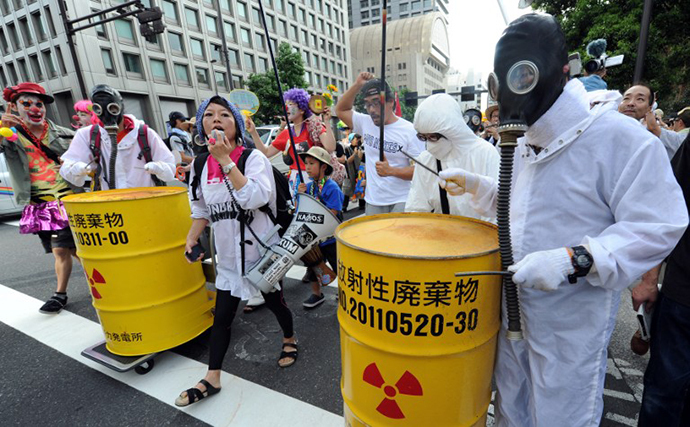
Number two, it’s very difficult to know what to eat in Japan
because you can’t taste or smell or see radioactive elements in
your food. And each dose of radiation that you get adds to the
risk of getting cancer. And as you eat more and more radioactive
food, more radioactivity builds up in various organs of your
body. There is little testing of food in Japan, the government is
lying to you, and they are encouraging the farmers in Fukushima
to grow their food, which is really criminal because there’s a
hell of a lot of fallout on the ground, in Fukushima, and the
radiation concentrates back from the soil into rice, green
vegetables, milk, meat, and the like.
They are even promoting the Fukushima food in Korea when I was
there, and in Taiwan, but also in Tokyo and other places, also in
markets in England, so the situation is very grim. And I think if
I lived in Tokyo, I would move south. And I would be very, very
careful about what I eat. I would only eat food coming from the
south of Japan, and I wouldn’t eat any fish because they are
pouring huge amounts of radiation into the Pacific Ocean every
day. And you don’t know which fish are radioactive and which are
not.
Q: Chernobyl happened in 1986, with very
radioactive rain over Europe. 40 percent of European area is now
covered with radiation.
HC: 40 per cent of the food in Europe is
radioactive. I do not buy European food or Japanese food.
Luckily, I live in Australia, but if you live in America, you
need not to eat Japanese or European food because you don’t know
what food is radioactive and what is not. And medically, you
mustn’t eat any radiation in food! And what’s more, Europe will
remain radioactive for hundreds or thousands of years!
And that’s so, too, with Fukushima. And the report of the
national Academy of Sciences in New York about Chernobyl says
[that] by now, about over a million people have died, not only of
cancer and leukaemia, but from other diseases from the
radioactive fallout, in Europe, as well as in Ukraine and Russia.
And if you extrapolate that data to Japan, [which is] much more
densely populated, we’re going to see a lot of cancers. Already,
in two-and-a-half years, they’ve diagnosed, or suspectedly
diagnosed, 44 cases of thyroid cancer, and thyroid cancer is
extremely rare, one in a million children get thyroid cancer. So
this indicates [that] those children and everyone else have
received extremely high doses of radioactive iodine and lots of
other elements, so that bodes very badly for the future, for the
Japanese people.
Q: We have learnt there were soya plants beginning
to grow in Chernobyl. Why can’t we do genetic studies on them and
adopt them in stable food crops to deal with radioactive exposure
in farmlands?
HC: Let me tell you there’s a wonderful scientist
called Timothy Mousseau, who is an evolutionary biologist, who is
going into exclusion zones, very radioactive zones around
Chernobyl and Fukushima, to the detriment of his own health. He
is looking at the birds and the insects, and the wildlife, plants
in those areas, and [found], first of all, that birds he was
looking at have smaller than normal brains because developing
brains are very sensitive to the effects of radiation. Many of
the male birds are sterile which means that they will die out.
They are covered with mutations, they have crooked tails, crooked
wings, white patches on them. Many of them have cataracts in
their eyes.

And what happens to animals, happens to humans, because we test all our drugs and medicine on animals before we give them to humans, so what we’re seeing in the animals which reproduce very fast and in which we watch generations and generations, is what will happen in humans.
There are 6,000 genetic diseases we now know of, including cystic fibrosis, diabetes, hemochromatosis, dwarfism, I could go on and on. And all of those diseases are going to increase in frequency down the time span because of radioactive pollution. It’s an absolutely wicked, wicked industry, which kills people.
And the other thing you need to know is that any country that has
a nuclear plant has a bomb factory. Nuclear reactors manufacture
250kg, or 500lbs, of plutonium a year. Plutonium has a half-life
of 24,400 years. It lasts for at least a quarter of a million
years. You only need five kilos or 10 pounds to make
an atomic bomb. So fundamentally, if you’ve got 500lbs of
plutonium, you need 10lbs for the bomb, you can make 50 atomic
bombs every year. America and Japan, and South Korea, are selling
nuclear reactors all around the world.
So not only are we selling cancer and leukemia to the future
generations, but they’re selling atomic bombs. That causes the
proliferation of nuclear weapons and increases the threat of
nuclear war.
Q: I feel like I’m dead already, and agree that it
is too late for me, but perhaps I can still do something good for
my children and hopefully for grandchildren, so count on me,
let’s clean the mess.
HC: Excellent! So what I would say to you, whichever
country you live in: you close down all your nuclear power
plants. America’s got over a hundred operating. They must all be
closed down. I don’t care what the laws say: laws are written to
protect corporations, not people. And you can’t tell me the power
of the people isn’t greater than the power of corporations – if
you love your children and your grandchildren, take it upon
yourself to shut down your local nuclear power plant.
‘We’re living with impending catastrophe every day’
Q: Do you see faster progress on the construction
of fusion reactors?
HC: No, fusion reactors are a dream for the
physicists, they haven’t been able to construct a fusion reactor,
I think that will never happen. But as Einstein said, the answers
to today’s problems will not be produced by the same technology
that caused them. We’ve got to change the way we think. And what
Einstein said - the splitting of the atom changed
everything, all reality, save man’s mode of thinking. Thus, we
drift towards unparalleled catastrophe. He was right so many
years ago - why do we keep doing it? Are we really lemmings
rushing towards the cliff of the nuclear annihilation and global
warming? Do we have the emotional intelligence to change the way
we think, and decide to save this beautiful planet of ours
and probably the only life in the universe? This is a very deep,
and spiritual, and religious question for those who are
religious.
Q: We’ve been hearing about the White House
meetings with the Japanese and TEPCO keen to help with the
clean-up. Is this true? Do you know and have you heard of
it?
HC: Yes, I do know that Secretary of Energy Ernest
Moniz has just been to Japan and visited Fukushima for the first
time. It’s taken him a long time to get there, and he was
terribly shocked. And he said that the Department of Energy would
help, but I know that TEPCO is about – in the next few days – to
start removing the spent fuel rods from the cooling pool. And two
things could happen: a rod could break and release a lot of
radiation and the workers will have to evacuate the whole of the
Fukushima complex. That’s terribly serious because they are there
every day to keep things going. Or two rods could touch each
other in this process which has been done before, and there could
be a fission reaction and a very large release of radiation. So I
don’t know what the plans are, they haven’t enunciated them.
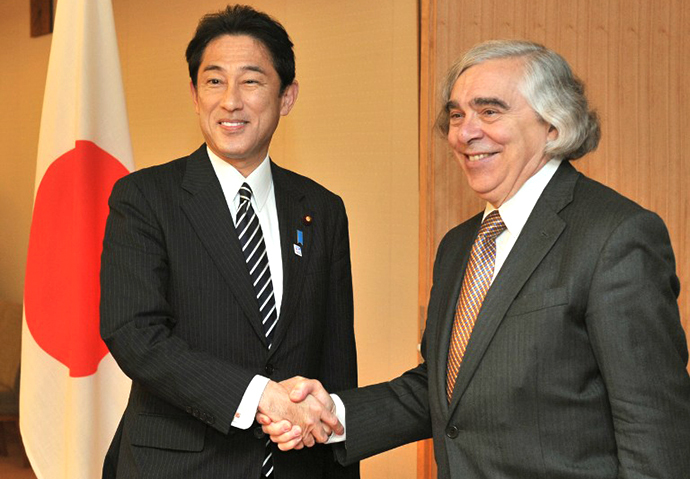
Q: What would you not hesitate to eat along the
Pacific Coast in North America?
HC: I don’t think I’d eat fish along the West Coast
of North America. I think the food is pretty safe at the moment.
I mean, that’s a guess. You should make sure that your
government, state and federal, are testing your food, so you know
what’s safe and what’s not. I think at the moment it’s probably
relatively safe, but as I said, we’re facing possible
catastrophe. It’s going to take them 14 months to remove those
spent fuel rods from Reactor 4 cooling pool. We’re living with
impending catastrophe every day.
Q: Nuclear is the only option if you want clear
skies. Nuclear is big in Europe. If you don’t want nuclear, you
must have dirty coal-powered stations, there’s no free
choice…
HC: That’s not true! If you download the study called
‘Carbon-Free, Nuclear-Free’ from the internet, the study
that I commissioned and organized several years ago with a
brilliant physicist called Arjun Makhijani, it shows that all
energy for Europe and for America, for every country, can be now
supplied by renewable energy.
Each day renewable energy gets cheaper and cheaper; cheaper by
far than nuclear. We mustn’t burn coal, you’re absolutely right,
but for God’s sake, why don’t the countries of the world stop
subsidizing nuclear, stop subsidizing fossil fuels, and cover
every house with solar panels, solar hot water system, solar
thermal systems like they’ve constructed in Spain, windmills?
I’ve just been in Germany and Austria, and lots of farmhouses are
now covered with solar panels. Germany is moving fast with
renewables. [As for] Denmark, 40 percent of its electricity comes
from wind.
The statements, views and opinions expressed in this column are solely those of the author and do not necessarily represent those of RT.
The statements, views and opinions expressed in this column are solely those of the author and do not necessarily represent those of RT.





